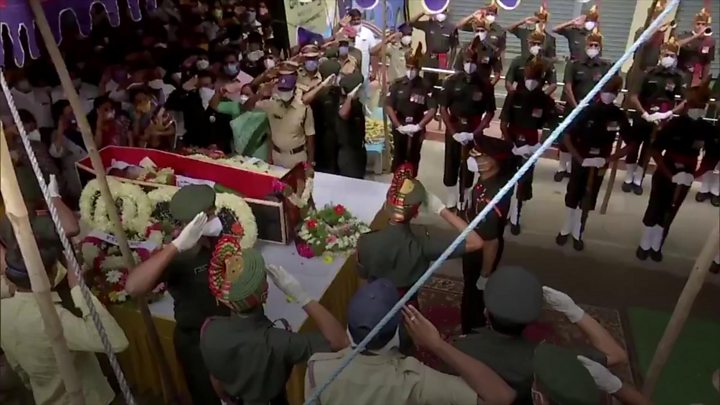China has accused Indian troops of a "deliberate provocation" in its first official comments on Monday's deadly clash at a disputed Himalayan border.
Foreign ministry spokesman Lijian Zhao said the troops had crossed into Chinese territory and attacked, triggering "fierce physical conflicts".
However he did not give details of any Chinese casualties.
On Friday Indian PM Narendra Modi said no foreign soldiers had crossed India's borders and no territory had been lost.
Mr Modi vowed that India would defend its border with military force if necessary.
- India and China downplay reports of soldier release
- The fake news about India and China's border clash
Twenty Indian soldiers were killed in the clash in the Galwan Valley. India has said that both sides suffered losses during the fighting.
What is China's version of events?
In a series of tweets, Mr Zhao said the Galwan Valley was on the Chinese side of the Line of Actual Control (LAC), the poorly demarcated border between the two nuclear-armed powers.
He said the clash occurred at a time when tension had been easing after India demolished infrastructure it had built on the Chinese side of the LAC in May and withdrew personnel, following an agreement between Chinese and Indian officers.
But on 15 June Indian troops "once again crossed the Line of Actual Control for deliberate provocation when the situation in the Galwan Valley was already easing", Mr Zhao said.
"India's front-line troops even violently attacked the Chinese officers and soldiers who went there for negotiation, thus triggering fierce physical conflicts and causing casualties," he said.
India has been building "roads, bridges and other facilities" at the LAC in Galwan Valley since April, Mr Zhao said.
What did PM Modi say about it?
In a televised statement on Friday, Mr Modi said there had been no incursion into Indian territory.
"Nobody has intruded into our border, neither is anybody there now, nor have our posts been captured," he said.
India's armed forces had been "given a free hand to take all necessary steps" to protect Indian territory, he added.
"The entire country is hurt and angry at the steps taken by China," he said, adding: "India wants peace and friendship, but upholding sovereignty is foremost."
His government had previously blamed China for the clash, with the foreign ministry releasing a statement on Wednesday saying it had been sparked after "the Chinese side sought to erect a structure in Galwan valley on our side of the LAC".
What happened in the Galwan Valley?
Media reports said troops clashed on ridges at a height of nearly 4,300m (14,000 ft) on steep terrain, with some soldiers falling into the fast-flowing Galwan river in sub-zero temperatures.
At least 76 Indian soldiers were reportedly injured in addition to the 20 dead. China has not released any information about Chinese casualties.
The fighting took place without any firearms because of a 1996 agreement barring guns and explosives from the area.
An image that emerged on Thursday purportedly showed some of the crude weapons used in the fight.
The photograph, which appears to show iron rods studded with nails, was passed to the BBC by a senior Indian military official on the India-China border, who said the weapons had been used by the Chinese.
The image was widely shared on Twitter in India, prompting outrage from many social media users. Neither Chinese or Indian officials have commented on it.
Why were there no guns?
The Galwan river valley in Ladakh, with its harsh climate and high-altitude terrain, is close to Aksai Chin, a disputed area claimed by India but controlled by China.
This is not the first time the two nuclear-armed neighbours have fought without conventional firearms on the border. India and China have a history of face-offs and overlapping territorial claims along the more than 3,440km (2,100 mile), poorly drawn LAC separating the two sides.
The last firing on the border happened in 1975 when four Indian soldiers were killed in a remote pass in the north-eastern state of Arunachal Pradesh. The clash was variously described by former diplomats as an ambush and an accident. But no bullets have been fired since.

Media playback is unsupported on your device
At the root of this is a 1996 bilateral agreement that says "neither side shall open fire... conduct blast operations or hunt with guns or explosives within two kilometres of the Line of Actual Control".
But there have been other tense confrontations along the border in recent weeks. In May Indian and Chinese soldiers exchanged physical blows on the border at Pangong Lake, also in Ladakh, and in the north-eastern Indian state of Sikkim hundreds of miles to the east.
India has accused China of sending thousands of troops into the Galwan Valley and says China occupies 38,000 sq km (14,700 sq miles) of its territory. Several rounds of talks in the last three decades have failed to resolve the boundary disputes.
World - Latest - Google News
June 20, 2020 at 01:41PM
https://ift.tt/2V3hChU
Galwan Valley: China accuses India of 'deliberate provocation' - BBC News
World - Latest - Google News
https://ift.tt/2SeTG7d
Bagikan Berita Ini














0 Response to "Galwan Valley: China accuses India of 'deliberate provocation' - BBC News"
Post a Comment